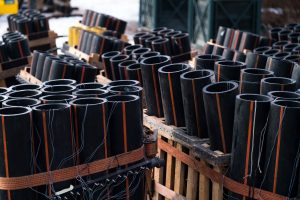
Planning on seeing some fireworks in the next few days? Maybe take a moment to appreciate the sheer ingenuity and science behind that exploding tapestry in the sky. Think of the long journey, the knowledge passed on to make this possible; generations innovating and expanding the work of those who came before. Fireworks have become an essential part of the American pastime, in fact according to the in 2018 there were 277.5 million pounds of fireworks consumed in the United States – that certainly makes for a big bang!
Accidental Origins
Fireworks have their origins in Chinese antiquity dating back as far as 200 B.C. when villagers discovered that bamboo thrown on an open fire created a crackling explosion. Hundreds of years later, an early form of gunpowder was discovered – a mixture of potassium nitrate, charcoal, sulfur, and other additives. This gunpowder was poured into bamboo tubes and the first primitive fireworks were launched into the sky. Modern fireworks are much more advanced with blasting shells, timed fuses, and a cascade of chemical reactions to produce a wide variety of colors, sounds, movements, shapes and effects. Often synchronized with recorded music or even a live band – fireworks are a technical display of precision as much as they are a patriotic one.
Programming Fireworks
Engineers and software are to thank for what you are about to witness this 4th. There is a great deal of science involved, quite a bit of mathematical calculation, and many hours of planning to make it all possible. The technicians who run large firework displays must complete hours of training. Simulations can now be run in programs such as SOLIDWORKS to see how the fireworks will be affected by gravity, air, wind speed, and the angle of the launcher. On the big night, the real world conditions will be factored in to give the crowd the best show possible.

The Evolution
Even in the past 20 years the evolution has been profound. Hand-lit fireworks advanced to electrically fired systems, which then moved to the modern computer fired displays. Computer fired fireworks are now the norm for large synchronized displays. Computer chips are sometimes implanted into the fireworks themselves for increased accuracy on height and to create specialized shapes in the air. Of course even a small malfunction in the system can make for a spectacular failure – though quite breathtaking in its own right.
The vibrant colors we see are created by the addition of . These metallic substances are heated so much that they vaporize and create the dazzling colors that make your eyes pop. The makeup of each firework is carefully tailored, if red, white, and blue are desired for instance burn strontium carbonate, magnesium alloy (not actually a salt), and copper chloride.
So this July, as you stare into the night sky, think of the long line of chemists, engineers, pyrotechnicians and software developers who helped paint the darkness with those glowing lights.

